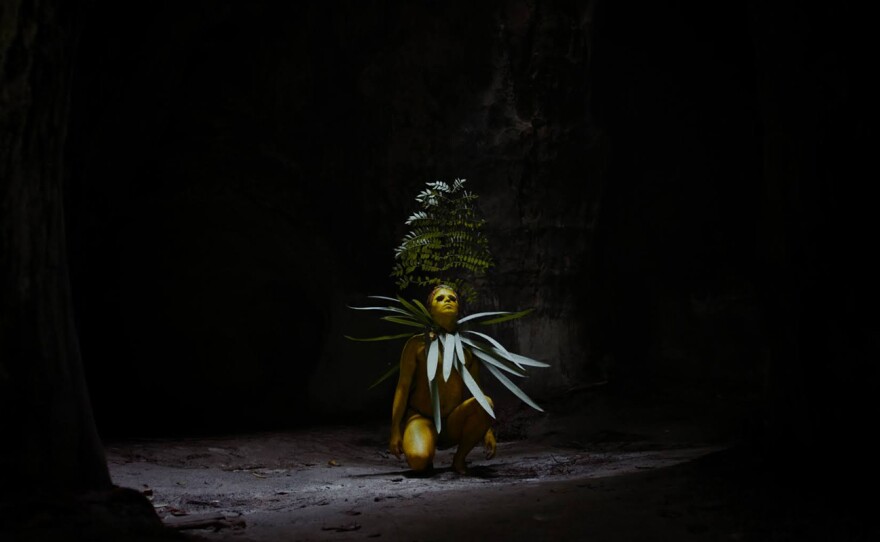Premieres Monday, Sept. 25, 2023 at 11 p.m. on KPBS TV / PBS App
Multi Emmy® Award-winning series, POV, illuminates Indigenous contemporary visual artist Uýra in director Juliana Curi’s feature documentary debut, “Uýra: The Rising Forest.” The lyrical and eye-popping film follows Uýra as they travel through the Amazon forest on a journey of self-discovery using performance art and ancestral messages to teach Indigenous youth the significance of identity and place, and how to confront structural racism and transphobia in Brazil.
In 1980, the town of Manaus in the Brazilian state of Amazonas had a river running through its center, providing the community with an abundance of fresh water. However, officials began to encourage the dumping of garbage into the river which impacted the health of the community. Now, decades later the artist Uýra conducts a performance piece dressed as a river creature dying in the middle of the debris to the crowds above them.

Director Curi follows Uýra’s journey as it takes them into the lush forests of the Amazon and beyond, gathering a group of LGBT members together through cultural centers and riverside communities. They share ancestral knowledge with Indigenous youth in the Amazon to promote the significance of identity and place, threatened by Brazil's far right oppressive political regime led by president Jair Bolsonaro and five centuries of severe colonial indigenous policies.

Through dance, poetry, and stunning characterization, Uýra confronts historical racism, transphobia, and environmental destruction, while emphasizing the interdependence of humans and the environment. Visually stunning—with impeccable cinematography by Thiago Moraes ‘Quadrado’—“Uýra: The Rising Forest," blurs the lines between documentary and fiction, showing that it's possible to address Brazil's structural violence while honoring the poetic aesthetic and enchantment of the Amazonian territory.

Filmmaker Quote:
“We could not approach this story with cartesian and linear perspectives,” said Director Juliana Curi. “We realized during the investigation process and filming that poetry and metaphor can have a powerful impact when we talk about socio-cultural issues. And, that this story has the power to break with the false segmentation that divides art films and social justice.”
“‘Uýra: The Rising Forest’ has already traveled to indigenous and riverside communities in the Amazon, has been shown in more than 35 film festivals around the world, and now reaches POV, one of the most relevant a communication channel in the world that supports films that can promote social and political change as they dismantle foundational myths that support the homophobic, transphobic and racist mechanisms in our society."

Film Awards:
“Uýra: The Rising Forest,” made its world premiere at Frameline46: The San Francisco International LGBTQ Film Festival in 2022, where it won the Audience Award For Best Documentary. It won Best Documentary at the New Filmmakers LA Film Festival, the Grand Jury Award at NewFest’s 34th Annual New York LGBTQ+ Film Festival, the Special Programming Award for Freedom at the 2022 Outfest Los Angeles LGBTQ Film Festival, the Jury Prize at London Film Week, Best Feature Documentary at the 2023 One World Media Awards in the United Kingdom, and was named the Best Indigenous Feature at the 2022 BendFilm Festival.

Festival Press Raves:
[an]“intricate weaving of environmental activism, indigeneity, performance art, queerness and transness.”– Jim Gilles, The Hollywood Reporter
“'Uýra: The Rising Forest' blurs the lines and boundaries that divide the documentary and fiction, as we are transported to the ancestral Amazonian enchanted world.”–Brian Bromberger, Bay Area Reporter

An Exhibition:
Works by Uýra are currently being shown at a solo exhibit at the Currier Museum of Art. Uýra uses organic elements (such as foliage, bark, fibers, plumage, and natural dyes) to create elaborate costumes that blur conventional separations between humans, animals, and plants. The hybrid creatures and performance freely move between the forest and the city, ultimately commenting on the impact of anthropocentrism and industrialization.

Watch On Your Schedule:
“Uýra: The Rising Forest” will be available for streaming concurrently with broadcast through Dec. 24, 2023 on all station-branded PBS platforms, including PBS.org and the PBS App, available on iOS, Android, Roku streaming devices, Apple TV, Android TV, Amazon Fire TV, Samsung Smart TV, Chromecast and VIZIO.

Credits:
A co-presentation with Latino Public Broadcasting (LPB), Peril and Promise, a public media initiative from The WNET Group, and POV. The director is Juliana Curi and the producers are João Henrique Kurtz, Juliana Curi, Lívia Cheibub, and Martina Sönksen. The co-producer is protagonist Uýra Sodoma. Juliana Curi and Martina Sönksen are the writers and Thiago Moraes ‘Quadrado’ is the cinematographer. The executive producers are Lívia Cheibub, João Henrique Kurtz, and Erika Dilday, Justine Nagan, and Chris White for American Documentary.
“After watching Juliana Curi's, 'Uýra: The Rising Forest,' all of us on the American Documentary team knew it was something special,” said Erika Dilday, Executive Director, American Documentary and Executive Producer, POV and America ReFramed. “The film's cinematic brilliance is breathtaking. Juliana's emotional intelligence in capturing the intersectionality between queerness, the environment, indigenous youth culture, mentorship and performance art is unmatched. This is a story that we know will transfix our audiences. At a time when misinformation and anti-LGBTQ sentiment has been in headlines across the U.S., it is more important than ever that we put front-and-center stories by and about non-binary artists."






